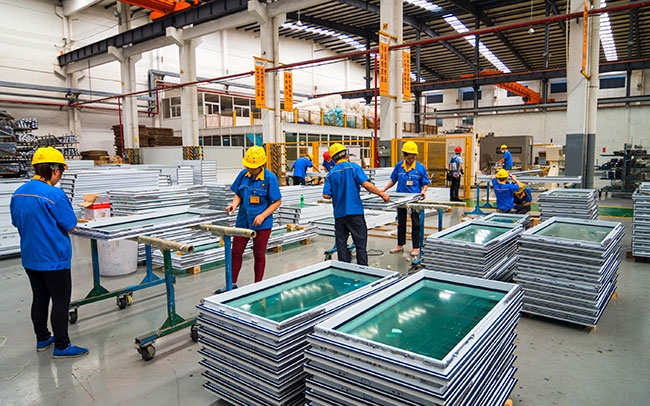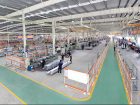
Features
Fabrication
Processing & productivity
Shadow of the dragon
A trade tribunal document reveals key aspects of two markets.
November 27, 2019 By Patrick Flannery
 With a manufacturing capacity we can scarcely imagine, the Chinese curtainwall industry has been found by Canadian authorities to pose a threat. Tariffs protect us for now. Photo credit: Guangliang Huo, Dreamstime.com
With a manufacturing capacity we can scarcely imagine, the Chinese curtainwall industry has been found by Canadian authorities to pose a threat. Tariffs protect us for now. Photo credit: Guangliang Huo, Dreamstime.comLast summer, the Canadian International Trade Tribunal had to decide whether to keep Canadian tariffs in place on unitized curtainwall modules imported from China, or to let them expire as scheduled in November.
The decision turned on whether allowing the tariffs to expire would result in “injury” to the Canadian curtainwall manufacturing industry.
The CITT sent out questionnaires and held hearings involving 40 industry representatives. It decided to “continue” its finding…in other words, the tariffs will stay in place for another five years. Those tariffs, originally applied in 2014, amount to close to 19 per cent on Jangho products, almost 55 per cent on Yuanda products and over 161 per cent on all other unitized curtainwall products originating in China. The effect of the tariffs, according to the evidence at the CITT hearing, was to effectively eliminate these imports from our market by 2016.
What was more interesting than the decision itself was the evidence presented at the hearing that is outlined in the Statement of Reasons attached to the decision. This is public information available on the CITT website under Decisions – Anti-Dumping Injury Decisions.
It’s a long, dry document, so here are some highlights.
The Chinese powerhouse
One of the eye-opening things in the statement are the details about Chinese manufacturing capacity. The total capacity in China for manufacturing unitized curtainwall specifically is estimated in the document at 156 million square meters per year. It’s noted that this is a low figure, since it’s referring to only unitized curtainwall modules and other kinds of unitized facade are not considered. The Tribunal estimates there are about 200 curtainwall manufacturers in China.
Just looking at the two Chinese manufacturers participating in the hearing, Yuanda and Jangho, the Tribunal found their production capacity to be approximately 48 million and 13.5 million square meters, respectively. Each Yuanda and Jangho plant can produce around three million square meters per year.
By comparison, total Canadian manufacturing capacity was estimated by the Tribunal to be one million square meters. To put it even more starkly, “Yuanda’s unused capacity at the end of the Period of Record exceeded the apparent size of the entire Canadian market.”
So one Chinese curtainwall manufacturer could replace all the curtainwall produced in Canada by adding a shift at one of its plants.
The relevance of our relative production capacities to the Tribunal is not hard to understand. If selling curtainwall at low margins was going to tie up a Chinese plant’s production with unprofitable work, the Chinese manufacturer would be unlikely to do that. But as the situation exists, the low-margin work would simply be eating up some spare capacity. Certainly worth it as an investment to grab international market share.
I visited China in 2010 and the reality of a country with over a billion citizens is something it is impossible to comprehend without seeing it firsthand. Container ships covering the ocean from horizon to horizon, waiting to enter the Shanghai harbour. Tower cranes everywhere, as far as the eye can see, across the entire western half of the city. A train that floats on magnets and takes you from the airport to downtown Shanghai in 20 minutes at 400 kilometers per hour. We think we are advanced and wealthy here in Canada. I hate to break it to you, but we are a backwater by comparison.
Which perhaps raises the question why a Chinese manufacturer would be interested in grabbing a share of our insignificant market. The Tribunal wondered the same thing and directed the question to Dr. Hon-Bo Wang of Yuanda USA. Wang cited Canada’s “stable demand, stable political situation, strong legal systems, high per capita income and large cities.” So it appears we are doing at least some things right. Compare the environment an exporter would face in many other parts of the world where demand and regulations could shift suddenly with unpredictable regime changes and wars; where property and bank accounts are not safe from corrupt officials; and where poor wealth distribution leaves investments vulnerable to sudden shifts in economic fortunes that impoverish paying customers.
These factors make Canada a sort of partial hedge against instability in China’s other markets. One downside of having such massive capacity is the need to constantly feed the beast with new work. The Tribunal notes that demand in China has softened recently as its government has taken measures to cool off an overheated real estate market. Attempts to reduce the exposure of Chinese banks to bad loans has led to a tighter financing environment for developers. The excess supply caused by this slowdown has created fierce competition in the domestic market. Far East Global, another Chinese manufacturer, described the Chinese domestic market as “fragmented and oversupplied” and prone to “disorderly competition.”
The Statement added some interesting economic forecasting to this analysis, predicting slowing global growth rates for the next year or two. The International Monetary Fund is calling for 3.5 and 3.6 per cent growth in the world economy in 2019 and 2020. But the big question marks are Brexit and Trump’s chaotic trade policy. A severe disruption in Europe coupled with the Tweeter-in-Chief capriciously shutting down trade would leave Chinese firms in a lot of trouble. While Canada could never make up for a major slowdown in these markets, it could at least provide a trickle of new money to help weather the drought.
The price is right
The Statement also provides something of a snapshot of the Canadian architectural glass market right now. The Tribunal notes that the industry is mainly driven by activity in Toronto and Vancouver, with individual large projects accounting for two to three per cent, or more, of the entire market in a given year. The bidding process is described as “informal,” with only a few bidders invited to take part. Lag times between proposals and delivery are pegged at around 12 to 18 months. The Tribunal says domestic producers fill most of the demand, bidding on around 10 to 12 projects a year with a success rate of about 30 per cent.
The continuing primacy of domestic suppliers, even in the face of possibly lower-cost offshore options, is related mainly to the risks project owners assume when they go outside the country for their curtainwall. The Tribunal lists the risks: inferior quality, unsafe products, untimely delivery and installation, differences in business culture, a lack of relationships with foreign suppliers and logistical challenges with shipping. Interestingly, it is the project owners who are more comfortable accepting these risks in order to get lower prices – general contractors and construction managers resist more frequently.
The Statement describes some risk-mitigation strategies. Ordering product for delivery well ahead of time is one, giving contractors time to identify quality problems and go back to the fabricator for solutions. Embedding consultants to oversee quality in overseas factories and on job sites is another.
The economic picture for the Canadian market was of demand exceeding supply, with three per cent decreases in demand in 2016 and 2017, but a 22 per cent increase overall since the tariffs were first put in place in 2014. Robert Quattrociocchi of EllisDon described it as a “supplier’s market,” and the contractors generally agreed that the big markets are still “hot.” Despite worries that Vancouver and Toronto have to slow down some time, the Tribunal predicted “stable” demand in the Canadian market in the near and medium term. The IMF predicts the Canadian economy will grow by 1.9 per cent in 2019 and 2020. The Tribunal found an overall increase in Canada’s total production volumes and exports to the U.S. almost doubling from 2015 to 2017. Those happy numbers were mitigated by a recent slowdown in exports, a shortening of backlog for 2020 and 2021 and concerns about low-priced competition in the U.S. Canadian plants are presently over 40 per cent under capacity, but this is not seen as a big problem in an industry that tends to go quickly from quiet shop floors to completely overloaded ones. All this has led to modestly higher margins on sales.
The Tribunal’s assessment of the effects of price on demand for curtainwall in Canada were worth a chuckle. The results of the fabricator survey indicated that the lowest-priced products usually win contracts. Quattrociocchi advanced his opinion that “price is not the only factor…with other important considerations being logistics, delay, quality and warranty.” Bryan Tucker of Westbank mentioned the importance of a relationship with the supplier.
The glass contractors present do not seem to have been disposed to accept these pious sentiments at face value. The Statement says, “A number of domestic producers stated that, in their view, price is often the deciding factor.” Ryan Spurgeon of Antamex called it “everything,” especially once bid-levelling was taken into account. Brian Cohen of BVGlazing chimed in to the same effect. One hopes there were no sharp objects handy. Quattrociocchi did end up admitting that developers are price-conscious and that, after bid-levelling, the lowest-price bid usually won.
Having established that price is king when it comes to bidding on unitized curtainwall projects, the Tribunal turned to looking at what the Chinese suppliers had done and were likely to do were tariffs removed. In the first investigation that led the imposition of tariffs, the Tribunal found “significant” price undercutting by Chinese manufacturers: 38 to 49 per cent for curtainwall and 16 to 28 per cent for window wall. On individual projects, the undercutting ranged from two to 71 per cent. It would take a whole lot of “relationship” to overcome that kind of discrepency. David Hudock of PCL said a 25 per cent price differential would be enough to trigger his company to look into using an overseas supplier, provided the risks could be mitigated.
What have we learned?
At the end of the day the Tribunal, unsurprisingly, found that Chinese unitized curtainwall exporters were likely to resume price undercutting if the tariffs were removed and Canadian curtainwall manufacturers were likely to suffer damage as a result. Shipping sufficient cut-rate curtainwall to Canada is just too easy for the massive Chinese producers and the Canadian market, while doing OK, is sufficiently price-sensitive that we would swiftly be reduced to an unsustainable sliver of market share.
Lobbying for tariffs rubs most glass people the wrong way. After all, aren’t we in business to compete and win? But there are two points here that make supporting tariffs against this part of Chinese industry not incompatible with a free trade stance. The first was contained in the original 2013 decision against China and the imposition of tariffs. That Statement of Reasons outlined a massive web of government subsidies supporting Chinese curtainwall producers. Back then, the Tribunal counted 30 Chinese government programs providing direct subsidies to their manufacturers and another 142 programs capable of providing indirect “upstream” aid. So Canadian glass companies aren’t just competing against their overseas counterparts – they are struggling against the unfathomable might of the Chinese government itself.
The second point is that we should perhaps be unwilling to pursue the path that has led China to its manufacturing dominance in the world. There’s little question that Chinese workers don’t enjoy the pay or protections that we do. The law in China is pretty much whatever Party officials say it is from day to day. Banks are told to give loans to favoured companies on whatever terms necessary. If tariffs are the price of being able to have a glazing industry on our terms, then perhaps they are justified by more than a straight economics calculation.
So we will be protected from the full force of competition with Chinese curtainwall for another five years. But whither our industry after that? Any number of shifts in politics and economics could see the tariffs not renewed next time. Rather than depend on the shield of the Canadian International Trade Tribunal, Canadian curtainwall manufacturers must continuously invest in innovation to improve our products and seek growth and market diversification around the world.
The players
The witness list at the April CITT hearing in Ottawa represented a who’s who of some of Canada’s biggest curtainwall producers.
- Dan Cummings, Antamex
- Ryan Spurgeon, Antamex
- Brian Cohen, BVGlazing Systems
- Mike Cornacchia, BVGlazing Systems
- Terence O’Bright, Contract Glazier
- Robert Quattrociocchi, EllisDon
- Frank Fischer, Ferguson-Neudorf
- Danny Neudorf, Ferguson-Neudorf
- Donald Delaney, Flynn
- Andrew Young, Flynn
- Regan Loehr, Inland Glass
- Brad Russell, Inland Glass
- David Hudock, PCL Constructors
- Martin Cash, Quest Window Systems
- Kevin Cosgrove, Quest Window Systems
- Stephen Charbonneau, Sotawall
- Jim Dol, Sotawall
- Paul Arnold, Starline Windows
- Nikki Carvalho, State Window
- Christopher Liberta, State Window
- Brian Dalgado, Toro Aluminum
- Franco Di Marco, Toro Aluminum
- Andrew Kay, Toro Aluminum
- Ryan Tripp, Toro Aluminum
- Bryan Tucker, Westbank
- Hong-Bo Wang, Yuanda
Print this page


Leave a Reply